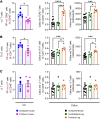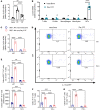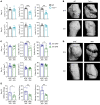Callus γδ T cells and microbe-induced intestinal Th17 cells improve fracture healing in mice
- PMID: 36881482
- PMCID: PMC10104897
- DOI: 10.1172/JCI166577
Callus γδ T cells and microbe-induced intestinal Th17 cells improve fracture healing in mice
Abstract
IL-17A (IL-17), a driver of the inflammatory phase of fracture repair, is produced locally by several cell lineages including γδ T cells and Th17 cells. However, the origin of these T cells and their relevance for fracture repair are unknown. Here, we show that fractures rapidly expanded callus γδ T cells, which led to increased gut permeability by promoting systemic inflammation. When the microbiota contained the Th17 cell-inducing taxon segmented filamentous bacteria (SFB), activation of γδ T cells was followed by expansion of intestinal Th17 cells, their migration to the callus, and improved fracture repair. Mechanistically, fractures increased the S1P receptor 1-mediated (S1PR1-mediated) egress of Th17 cells from the intestine and enhanced their homing to the callus through a CCL20-mediated mechanism. Fracture repair was impaired by deletion of γδ T cells, depletion of the microbiome by antibiotics (Abx), blockade of Th17 cell egress from the gut, or Ab neutralization of Th17 cell influx into the callus. These findings demonstrate the relevance of the microbiome and T cell trafficking for fracture repair. Modifications of microbiome composition via Th17 cell-inducing bacteriotherapy and avoidance of broad-spectrum Abx may represent novel therapeutic strategies to optimize fracture healing.
Keywords: Bone Biology; Bone disease; Microbiology; Orthopedics; T cells.
Conflict of interest statement
Figures







Comment in
-
Gut T cells help mediate fracture healing.Nat Rev Rheumatol. 2023 May;19(5):258. doi: 10.1038/s41584-023-00961-1. Nat Rev Rheumatol. 2023. PMID: 37020106 No abstract available.
-
T cells heal bone fractures with help from the gut microbiome.J Clin Invest. 2023 Apr 17;133(8):e167311. doi: 10.1172/JCI167311. J Clin Invest. 2023. PMID: 37066879 Free PMC article.
References
Publication types
MeSH terms
Substances
Grants and funding
- R01 DK112946/DK/NIDDK NIH HHS/United States
- S10 RR028009/RR/NCRR NIH HHS/United States
- U54 AG062334/AG/NIA NIH HHS/United States
- R01 AR079298/AR/NIAMS NIH HHS/United States
- R01 DK119229/DK/NIDDK NIH HHS/United States
- R01 DK124821/DK/NIDDK NIH HHS/United States
- R01 AR080750/AR/NIAMS NIH HHS/United States
- R01 AR073874/AR/NIAMS NIH HHS/United States
- I01 BX005062/BX/BLRD VA/United States
- I01 BX005852/BX/BLRD VA/United States
- R01 AR068157/AR/NIAMS NIH HHS/United States
- R01 AR070091/AR/NIAMS NIH HHS/United States
- I01 BX000105/BX/BLRD VA/United States
- R01 DK098391/DK/NIDDK NIH HHS/United States
LinkOut - more resources
Full Text Sources
Molecular Biology Databases

